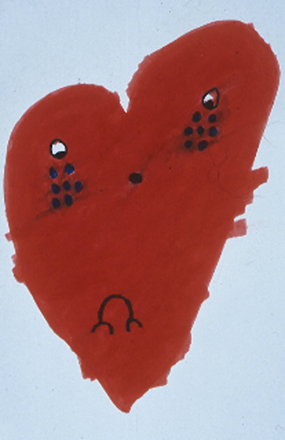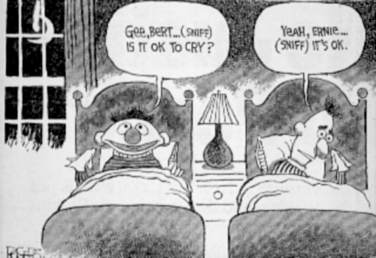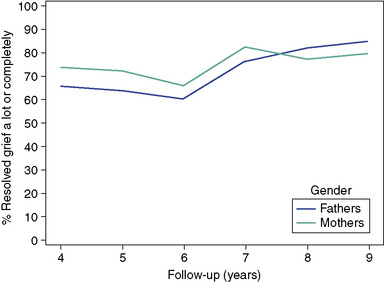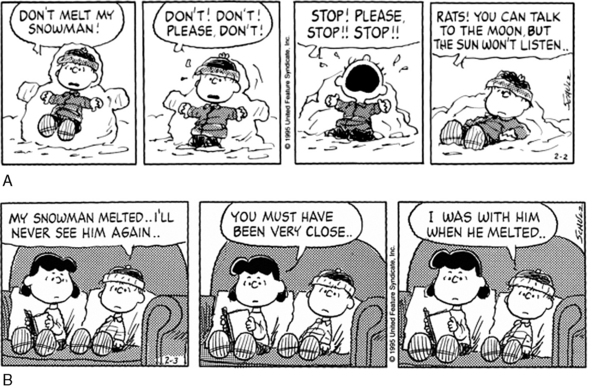5 Anticipatory Grief and Bereavement
I didn’t know what ‘metachromatic leukodystrophy’ meant. I asked for an explanation and when they told us it was something to do with his brain I just kind of panicked and freaked out… His mental abilities are going to be changing and I think having the mental aspect going in his life is going to be a big situation in our lives… When he’s not going to acknowledge or know who we are is going to be a big issue. [tears]. We know he’s going to die and his life expectancy is a lot shorter, which makes it very hard. I’m not ready for that. I don’t think I’ll ever be ready for that but I’m going to do my best.1
Imagine—I was only eight years old when my brother died! Now I have to live with this for the rest of my life.2
When my son died, visitors offering their condolences, thinking to comfort me, said: ‘Life goes on.’ What nonsense, I thought, of course it doesn’t. It’s death that goes on. My child is dead now and will be dead tomorrow and next year and forever. There’s no end to that. But perhaps there will be an end to the sorrow of it. Sorrow has rushed over the world like the waters of the Deluge, and it will take time to recede.3
Anticipatory grief and bereavement—the before and after of loss—comprise physical, psychological, spiritual, social, and cultural facets. Webster’s Dictionary defines “bereaved” as “a word derived from ‘reaved’ or ‘reft’ meaning: to deprive and make desolate, especially by death”4 (Fig. 5-1). Bereavement is a process that ebbs and flows over a lifetime. At its core is the child, surrounded by concentric circles of family, friends, members of the professional team, and the wider community and culture.

Fig. 5-1 A heart weeping.
(Reprinted from Sourkes, B. et al. Food, toys, and love: pediatric palliative care. Curr Probl Pediatr Adolesc Health Care 35(9): 345–392, 2005.)
Over the past decade of research, the perspectives of bereaved parents have proved to be an invaluable resource for the development of pediatric palliative care.5–7 Such research has explored the care provided to the child and family throughout the illness and into bereavement, rather than an exclusive focus on the loss itself.8–9 Approaching bereaved families for research purposes had been questioned in terms of the risk of inflicting psychological harm or distress.10 Yet several studies have shown that parents find participation to be a positive and therapeutic experience—more so than non-bereaved parents.11–13
This chapter focuses on the interplay between the universality of the grief experience and the uniqueness of each individual and family’s response. The phenomenon of anticipatory grief in the family is described, followed by a discussion of bereavement (Box 5-1). Particular emphasis is on the role of assessment in bereaved families and the implications for intervention, including cultural and spiritual dimensions. Clinical vignettes of bereaved families highlight the themes of the chapter. The grief of the palliative care clinicians who care for these children and families is also addressed.
BOX 5-1 Anticipatory Grief and Bereavement: Key Concepts
Anticipatory Grief
Bereavement
The Family Unit
In modern times, the definition of family has expanded to encompass many diverse constellations. From the outset, a family’s own definition of their family unit and the role of each member should be elicited. Without such information, clinicians’ assumptions of inclusion or exclusion may be faulty, and valuable sources of support overlooked. The nuclear family of child, siblings, and parents is at the core, surrounded by the extended family. In particular, grandparents frequently play a major role. Close friends may be indistinguishable from family, especially in palliative care situations. With the changing structure of the family, latitude must be made for alternative and complicated arrangements. These include divorced and reconstituted (blended) families, with their inherently conflicted histories and new alliances; single-parent families; and children of gay parents.14 The composition of the family frames many other factors, including developmental level; psychological history, particularly coping with past losses and trauma; sources of support; and cultural and spiritual beliefs.
The developmental level of the family unit is frequently a salient dimension in the impact of a child’s illness and death.15–18 Young parents are often just learning how to incorporate children into their relationship as they begin to expand their definition of family. The premature death of a young child can send parents reeling into uncertainty about their identity: Are they still parents? Are they still a family? Furthermore, with little prior experience of negotiating loss or death as a couple, they may experience confusion and fear about each other’s reactions. These families often need more structured guidance than an older family that has already negotiated previous losses.
A universal phenomenon in the bereavement process is that individuals in the same family grieve in different ways and on different schedules.15–18 Despite mourning the same child, family members are often out of sync with one another in their experience and expressions of grief. Misunderstanding, guilt, anger, and resentment, and a profound loneliness, often arise when this phenomenon is not understood.
It is crucial to recognize the impact of background, culture, and language on the family’s experience of the child’s illness and treatment, how they make decisions along the way, and on the grief process.19 Cultural perceptions may challenge the use of language. For instance, in English, compassion connotes a deep caring. In some Spanish traditions, however, the word is primarily connoted with care for the dying. Thus, compassion may communicate an unintended message to the family. Deepening the awareness of such nuances and differences enables bereavement care to begin where the family is cuturally.
As for children, their modes of expressing grief may differ substantially from adults’ and thus their grief’s meaning and depth are often underestimated or even missed completely (Fig. 5-2). All too often, siblings become disenfranchised grievers,20 their loss is minimized compared to that of their parents’. They are often admonished to be strong for their parents with little acknowledgment of their own mourning process.2
Current Research
Parents
The loss of a child is described as one of the most stressful life events possible.21 The grief is more intense and longer lasting than that following any other type of loss.22 Some studies suggest it may take at least four to six years to “work through” the death of a child23 (Fig. 5-3). The loss itself is compounded when parents have witnessed their child’s protracted physical and emotional suffering throughout the illness.24–26 Despite the traumatic nature of the experience, and the fact that bereaved parents are at increased risk of physical and psychological morbidity,27–29 most individuals are able to come to terms with the loss over time. Two types of factors have been studied for their impact on bereavement outcome in parents: those that can be managed (modified or avoided) in the current health care setting, and those that cannot.
Factors that lie beyond the scope of the healthcare setting include a family’s history of previous losses, pre-morbid conditions, and financial problems. Even the age and gender of the child has been found to affect parental bereavement outcome.27,30,31 For fathers, the risk of anxiety and depression is greater after the death of a child older than 8, nearly twice as high as those fathers whose younger child died.27 No such relationship to the child’s age is seen in mothers. Gender of the child also affects mothers and fathers differently. The risk of morbidity in mothers is higher when a daughter dies.31 Although such factors are not changeable, it is extremely important for clinicians to be aware of them in their daily work with families.
Factors that can be modified within the healthcare setting are all related to the quality of palliative care. For example, the absence of clinicians at the moment of a child’s death increases the likelihood of parents reporting unrelieved pain, as well as an intensely difficult death.8 Location of the child’s death is another factor in bereaved parents’ morbidity: fathers are less likely to suffer from depression if the child dies at home.32 It must still be determined whether the significant factor is the actual location of the child’s death—or the planning of it.33
Open and honest communication has been emphasized as crucial in pediatric palliative care.34–36 It has been found that providing psychological support to parents from the healthcare team, even in the last month of their child’s life, facilitates their grieving process. Informing families about the evolving nature of a child’s illness and prognosis is always challenging. Communication about the child’s prognosis has proved valuable for the bereavement outcome.23 Although most parents want to be fully informed of their child’s status, many clinicians continue to avoid this type of communication. Parents who have been informed that their child’s death is imminent are, not surprisingly, more likely to be aware of the pending death.37 Their awareness impacts the opportunity for them to tailor the child’s care according to their wishes. Bringing the child home, as well as planning for a death at home, is more likely to be considered if parents are cognizant of the imminence of death.38 Furthermore, these parents are more likely to talk about death with their child, even more so when they perceive the child also to be aware, which is an approach that has been shown to reduce the risk of psychological morbidity in bereavement.39 However, many children in pediatric palliative care are unable to engage in any type of communication because of age, developmental delay or the nature of the illness. Mothers of children who had severe malignancy and were unable to communicate in their last week of life were more likely to think that death would be best for the child; this finding was not consistent for the fathers.40
Assisting bereaved families is an integral part of pediatric palliative care, beginning with the issues around anticipatory grief at the child’s diagnosis. However, research on bereavement intervention is still in its early stages, and the efficacy of counseling has not yet been well validated.41 Several studies have shown that both professional and social support is beneficial for parents’ grief outcomes, although not all parents find it helpful. Some parents choose to cope on their own, with or without support from family or friends. Over the long term, the social network has proved to be particularly valuable for many bereaved parents. Fathers talk mainly with their spouse, while mothers confide in family, friends, and other bereaved parents. Both types of sharing have a beneficial impact on the grief outcome.23 The identification of parents at risk for pathological grief reactions, and designing optimal intervention for them, remains a critical topic for future research. Emerging from the research are the following recommendations in caring for bereaved parents:
Although long-term consequences often refer to sequelae one or two years following a loss, a time frame for parental bereavement has not been established in the literature.42 Hospitalization for psychological morbidity and an elevated incidence of death have been reported as long-term consequences following the death of a child.28,43 In a Danish study, it was found that both natural and unnatural deaths are more likely among bereaved parents than in a matched sample who were not bereaved. Bereaved mothers had an increased risk throughout the study period of 3 to 18 years, while for fathers the risk was limited to the first 3 years. Unresolved grief emerges as a specific risk factor for the psychological and physical health of both mothers and fathers in the long term. Bereaved fathers with unresolved grief are seven times more likely to report sleep disturbances,44 with the ensuing impact on their capacity for work and overall well-being. A common, and damaging misconception, is that the incidence of separation or divorce is elevated in couples whose child has died. Yet a recent study on long term marital status shows the opposite: bereaved parents actually are less likely to divorce or separate than non-bereaved.45
Siblings
Research on bereaved siblings is extremely limited; their long-term adjustment has yet to be explored in a systematic fashion. However, certain issues have emerged in both clinical observations and empirical studies.46–51 Siblings are often referred to as being invisible because of the parents’ intense involvement in the care of their ill child.52,53 During the illness, the siblings desire open and honest communication within the family, adequate information from clinicians, involvement in the care of the sick child, and support to continue their own interests and activities.52–54 Parents often try to protect the siblings from involvement in the child’s illness, particularly end-of-life care, thinking that it will shelter them from trauma. Yet this well-intentioned approach instead leads the siblings to feel abandoned and excluded from the family tragedy,55 with these feelings persisting long into bereavement. Findings suggest that after the death, siblings perceive their life to change, not only within the family but also in relationships with others outside the family. Clinicians can play an important role in communicating directly with siblings whenever possible and educating the parents about the importance of addressing their needs.
Anticipatory Grief
Anticipatory grief is the process that links everyone who is facing the loss of the child. It is catapulted into being at the time of diagnosis, and wends its way through the illness trajectory until the moment of death. Anticipatory grief initially resembles the grief that immediately follows a death: emotions are alternately raw and numb, and very much in evidence.56 The classic definition of anticipatory grief is “grief expressed in advance when the loss is perceived as inevitable.”57 A broader definition includes loss that is threatened, with the implication of a much longer time frame. Experientially the process reflects the emotional response to the pain of separation before the actuality of loss. The child grieves multiple losses: of his or her healthy self, of function and role, of separation from loved ones. (For discussion of anticipatory grief in the child, see Chapter 3.) The family members face anticipatory grief, and then bereavement after the child dies. They move from the realization that “Our child is going to die” to an even more anguished dawning that “We are going to lose our child.”56 It is at this juncture that the recognition of an inevitable separation has begun. The ebb and flow of anticipatory grief charts an individual course for each family, dependent on the nature and length of the illness trajectory, as well as psychological and cultural factors.
Katy, a 7-year-old girl, had a recurrent dream: “I want to be with my mother, and I can never quite get to her.” The girl recounted the dream in a joint psychotherapy session with her mother. Whereas the mother found the dream “excruciating,” her daughter articulated that “even though the dream is very sad, it’s not a nightmare.” The dream eventually provided the focal image for mother and child to work through the anticipatory grief process.56,p. 70
These phenomena are neither inevitable, nor, when they occur, irreversible. However, they do signify a family’s difficulty in negotiating a phase of the anticipatory grief process. It is crucial that the family not feel chastised for their distancing maneuvers. Rather, this is often a time for a referral to a mental health clinician for individual, marital, or family therapy.56
Three healthy siblings complained to the psychologist: “Every holiday our parents say: ‘Let’s make this holiday perfect for your brother, since it may be his last.’ Meanwhile, he has lived for four years. How long are we supposed to keep this up?”56,p. 73
Enormous grief and anticipatory grief are engendered by the death of another patient. The reverberations are particularly intense when the children have the same disease. On one level, the child and family grieve the loss of their acquaintance or friend. On a deeper level, they are struck with the awareness: “This could have been me/our child … and will I/our child be next?”56 This close sense of identification provides an opening for the child and family to address their own sadness and fear. It is a time for the clinician to be actively present and reassuring until the acute anxiety and grief abate.
With the approach of the child’s death, the family confronts the full intensity of anticipatory grief. The child faces the ultimate leave-taking from everyone and everything; the family stands at the brink of their new life ahead, facing the specter of life without the child. This sequence of anticipatory grief and then bereavement is represented metaphorically (in Fig. 5-4): desperate, powerless and ultimately unsuccessful pleas to prevent the death of a loved one followed by ensuing sadness and attempts at solace.
Bereavement
Death ends a life, but it does not end a relationship…
Parenting is a permanent change in the individual. A person never gets over being a parent. Parental bereavement is also a permanent condition. The bereaved parent, after a time, will cease showing the… symptoms of grief, but the parent does not “get over” the death of a child.59, p. 178
Bereavement follow-up by the professional team is an intrinsic component of comprehensive pediatric palliative care. Without such continuity, many families express anguish over the experience as a double loss. Primary is the death of their child, of an individual, and of a member of the family and the greater community. Compounding this grief, they mourn the loss of their professional family – the treatment team whom they have known and trusted, often over months and years.5–7,9,60Contact from a team member after the child’s death not only assuages the family’s sense of abandonment, but it can also serve a crucial preventive role by identifying families at risk for serious physical, psychological, and social sequelae.
Assessment
A bereavement assessment61 is often done over several sessions, beginning in some instances in the immediate aftermath of the child’s death, and then followed up over weeks or months. The clinician must carefully monitor the pace of the assessment, both within meetings and in scheduling subsequent times, always based on the family’s cues. “Plowing through” an interview for the sake of completing the assessment frequently results in distress and the loss of important information (Box 5-2).
BOX 5-2 Fundamentals of Bereavement Assessment*
Stay updated, free articles. Join our Telegram channel

Full access? Get Clinical Tree





